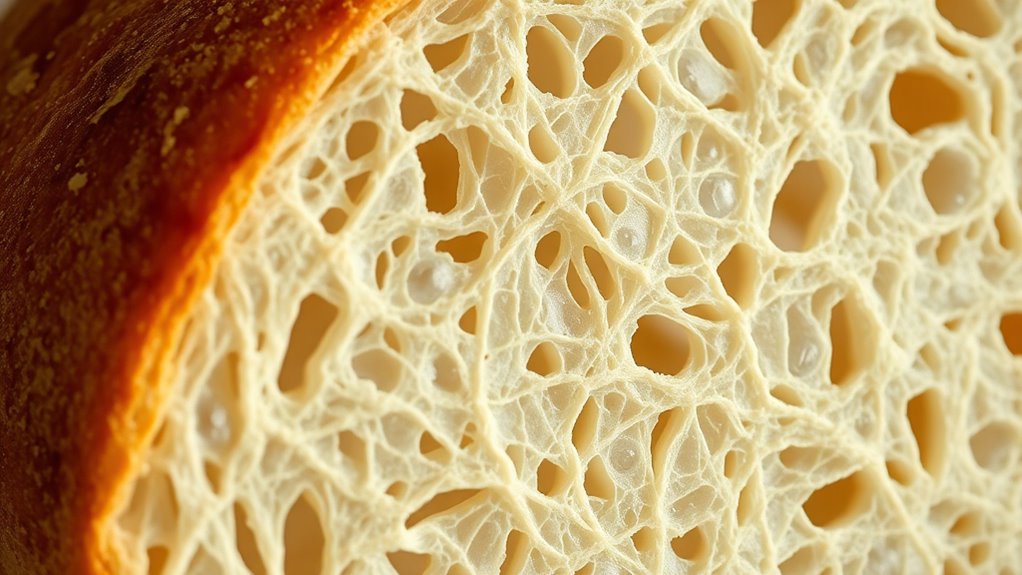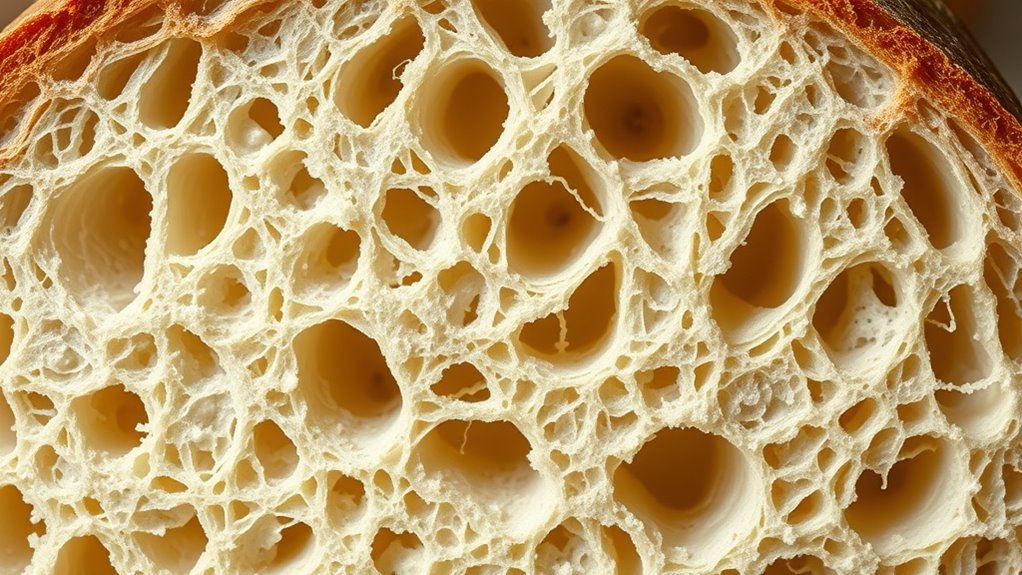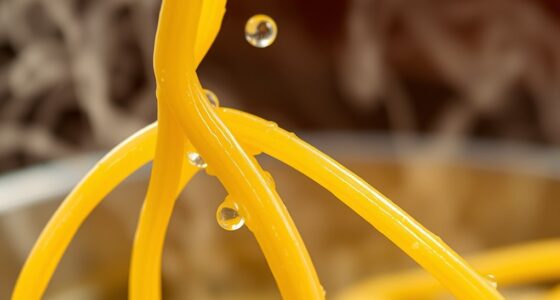To understand gluten networks in Italian bread, focus on how flour and water combine to form stretchy, resilient strands through kneading. These gluten strands trap carbon dioxide from yeast, helping your bread rise and develop a light, airy crumb. The quality of the gluten network impacts how well the dough holds gases and shapes during baking. By mastering hydration and kneading techniques, you can enhance your bread’s texture—continue exploring to learn more about perfecting your dough.
Key Takeaways
- Gluten networks develop during dough mixing and kneading, providing elasticity and structure essential for Italian bread texture.
- Proper gluten formation traps carbon dioxide, enabling the bread to rise with an airy, open crumb.
- Factors like hydration levels and kneading technique influence the strength and resilience of gluten networks.
- Well-developed gluten results in lighter, more open crumb, while weak gluten yields denser loaves.
- Monitoring dough elasticity indicates gluten development quality, affecting final bread shape, texture, and rise.

Italian bread varieties owe much of their distinctive texture and flavor to the structure of gluten networks within the dough. When you begin mixing flour and water, you’re initiating gluten formation, a process that develops the stretchy, resilient framework responsible for the bread’s characteristic chewiness and airy crumb. As you knead the dough, gluten strands start to align and bond, creating a network that traps carbon dioxide produced by yeast. This gluten network gives the dough its dough elasticity, allowing it to stretch without tearing, which is essential for trapping enough gas to help the bread rise properly.
The quality of gluten formation directly impacts the final product. If the gluten network is well-developed, your bread will have a light, open crumb with a pleasing chew. Insufficient gluten development results in a denser loaf with less lift and a tighter crumb. To achieve ideal gluten formation, you need to knead the dough thoroughly—this process encourages gluten strands to cross-link and strengthen. In many Italian bread recipes, kneading is a critical step because it ensures the dough becomes elastic enough to hold gases during fermentation and proofing stages.
Dough elasticity is a key indicator of successful gluten development. When you stretch the dough gently, it should elongate smoothly without tearing. This elasticity shows that the gluten network is resilient and flexible, capable of expanding as the dough rises. If the dough feels too stiff or resists stretching, it may lack enough hydration or needs more kneading. Conversely, if it’s overly sticky and difficult to handle, it might be over-hydrated or require additional flour. Achieving the right balance ensures the gluten network is strong yet flexible, which is essential for shaping, proofing, and baking Italian bread with the desired texture. Additionally, understanding the hydration level of your dough can influence gluten development and overall bread quality.
Frequently Asked Questions
How Do Gluten Networks Influence Bread Texture?
Gluten networks directly impact bread texture by providing gluten elasticity and dough extensibility. When gluten develops well, your dough becomes stretchy yet resilient, giving the bread a chewy, airy crumb. If the gluten network isn’t strong enough, the dough may tear easily and result in dense bread. Conversely, overly developed gluten can make the bread tough. Balancing gluten elasticity and extensibility guarantees your bread has the perfect texture—light, chewy, and satisfying.
Can Gluten Development Affect Bread Shelf Life?
Did you know that proper gluten development can extend bread’s shelf life by up to 20%? When you develop gluten well, it improves gluten shelf stability, helping the bread stay fresher longer. This also enhances preservation effects by maintaining structure and moisture. So, by controlling gluten development during baking, you can enjoy longer-lasting bread, reducing waste and ensuring a better texture over time.
Are Gluten Networks Different in Gluten-Free Italian Breads?
You might notice that gluten networks in gluten-free Italian breads differ considerably from traditional ones. Gluten-free alternatives rely on different ingredients like rice flour or tapioca starch, which don’t form the same strong gluten structure. To mimic traditional textures, bakers use specific gluten-free baking techniques, such as adding xanthan gum or guar gum. These adjustments help create a desirable crumb, even without the typical gluten network present in traditional Italian breads.
What Role Does Water Quality Play in Gluten Formation?
Water quality greatly impacts gluten formation, as water mineral content and pH level influence dough development. Hard water with high mineral content can strengthen gluten networks, making dough more elastic. Conversely, soft water with low mineral content may weaken gluten strands. pH levels also matter; slightly alkaline water enhances gluten structure, while overly acidic water can hinder it. Using quality water guarantees consistent, well-developed gluten in your bread.
How Does Fermentation Time Impact Gluten Network Strength?
Imagine that fermentation duration is the secret ingredient to releasing the full power of gluten strength. As you extend fermentation time, you allow enzymes to break down proteins, creating a more elastic and resilient gluten network. This not only improves dough elasticity but also enhances bread texture. So, by carefully controlling fermentation, you transform ordinary dough into a masterpiece of strength and structure, elevating your baking game to legendary status.
Conclusion
Now that you understand how gluten networks shape Italian bread, you can truly appreciate their magic. With just the right gluten structure, your bread transforms into a masterpiece of flavor and texture—almost like a culinary symphony in every bite. So next time you bake or savor Italian bread, remember, you’re experiencing a craft that’s as intricate and legendary as the art itself. Get ready to elevate your bread game to legendary status!









